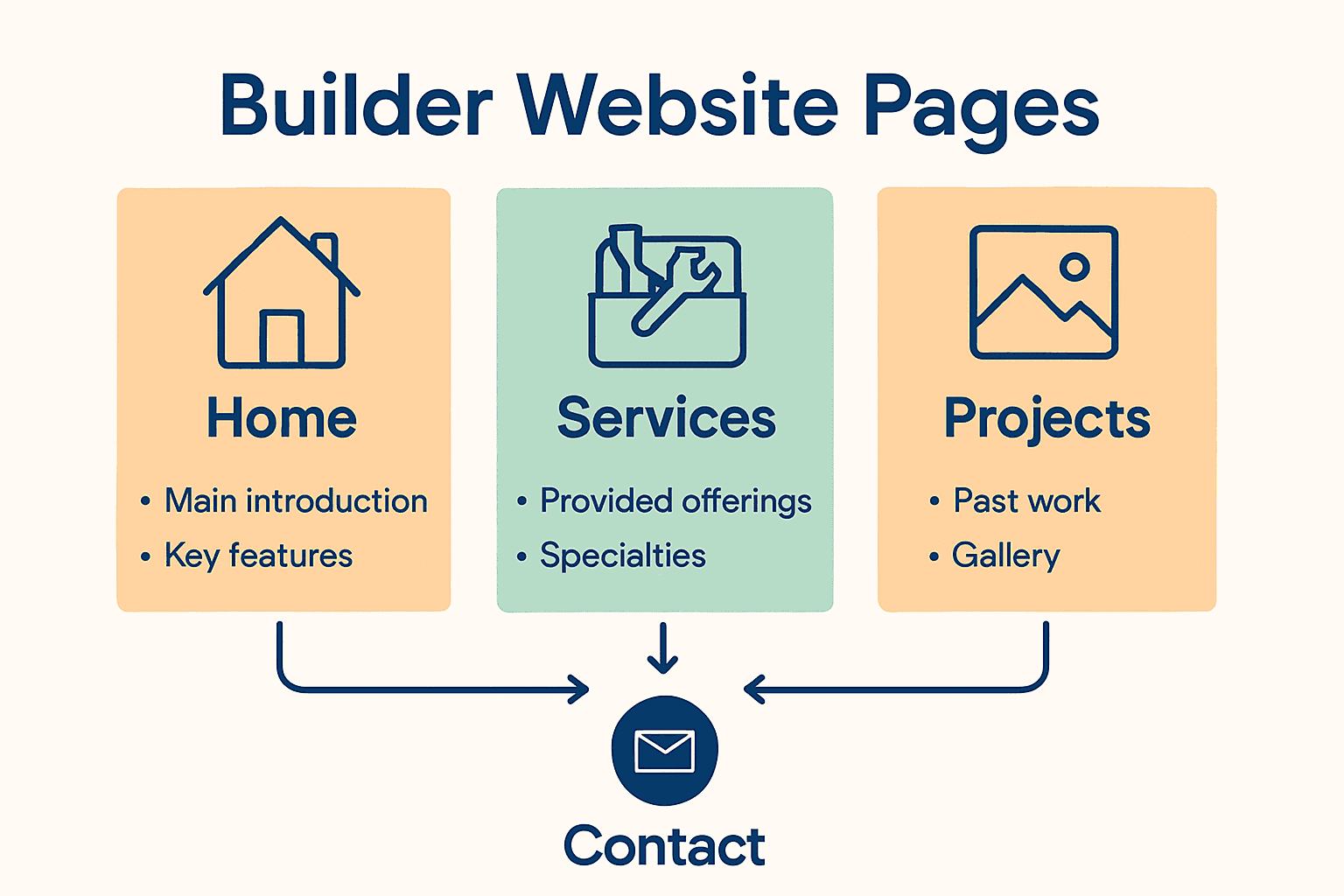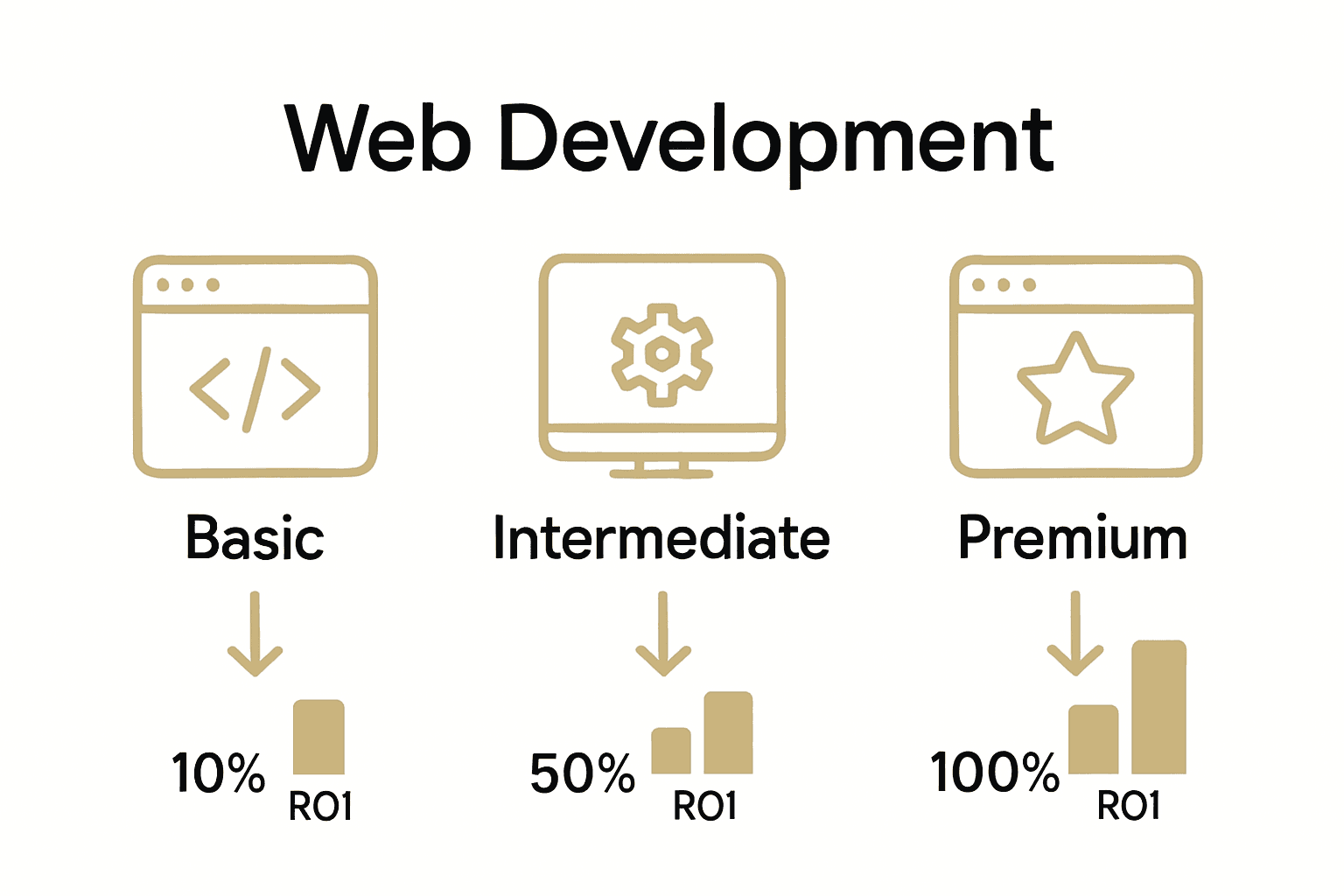Did you know that more than 60 percent of internet traffic now comes from mobile devices? As digital habits change, users expect websites to adjust automatically to their screens. Responsive design bridges this gap by making every site easy to use, no matter the device. Adopting this approach means smoother user experiences, higher retention rates, and better outcomes for businesses competing in a crowded online world.
Key Takeaways
| Point | Details |
|---|---|
| Importance of Responsive Design | Essential for providing a seamless user experience across devices, improving engagement and retention. |
| Core Techniques | Fluid grids, flexible images, and media queries are fundamental for achieving adaptability in design. |
| Business Necessity | Ignoring responsive design risks losing potential customers as mobile usage continues to rise. |
| Challenges to Consider | Designing for various devices requires attention to navigation, performance optimization, and cross-platform testing. |
Table of Contents
- Defining Responsive Design And Its Importance
- Core Principles And How Responsive Design Works
- Key Benefits For Businesses And Users
- Common Challenges And How To Avoid Them
- Responsive Design Vs Other Web Approaches
Defining Responsive Design and Its Importance
Responsive web design transforms how websites appear and function across different devices, creating a seamless digital experience that adapts dynamically. According to research from Wikipedia, this approach ensures web pages render effectively on smartphones, tablets, laptops, and desktop computers by utilizing sophisticated design techniques.
At its core, responsive design employs three fundamental techniques to achieve flexibility:
- Fluid proportion-based grids that automatically adjust layout dimensions
- Flexible image scaling that maintains visual quality across screen sizes
- CSS media queries enabling precise layout adjustments based on device characteristics
The primary goal of responsive design goes beyond mere visual adaptation. It aims to deliver an optimal user experience by ensuring that website content remains readable, navigable, and visually appealing regardless of the screen size. Learn more about responsive web design principles to understand how these techniques create websites that look great everywhere.
Businesses today cannot afford to ignore responsive design. With mobile internet usage continuously increasing, a website that doesn’t adapt to different devices risks losing potential customers. Statistics consistently show that users quickly abandon websites that are difficult to read or navigate on their specific device, making responsive design not just a feature, but a critical business necessity.

“Responsive design is no longer optional – it’s essential for digital success in a multi-device world.” – Web Design Experts
Customer Review:
“Our website traffic increased by 45% after implementing responsive design. Absolutely game-changing!” – Sarah Thompson, Local Auckland Business Owner
Core Principles and How Responsive Design Works
Responsive design operates through three fundamental technical principles that work together seamlessly to create adaptable web experiences. According to research from Wikipedia, these core principles include fluid grids, flexible images, and CSS media queries which collectively enable websites to transform gracefully across different devices and screen sizes.
The first principle, fluid grids, replaces traditional fixed-width layouts with proportional sizing using relative units like percentages. This means page elements automatically resize and reposition themselves based on the screen’s dimensions, creating a dynamic and flexible layout. For instance, a column that occupies 50% of a desktop screen will proportionally adjust on a tablet or mobile device, maintaining visual hierarchy and readability.
Flexible images complement fluid grid systems by ensuring visual content scales appropriately without losing quality or causing layout disruptions. Explore our web design principles guide to understand how images can be made responsive through CSS techniques like “max-width: 100%” and height: auto.
The final critical component is CSS media queries, which act like intelligent switchboards directing layout changes. These queries detect specific device characteristics such as screen width, orientation, and resolution, allowing designers to apply targeted style rules. By using breakpoints, websites can dramatically transform their appearance and functionality across different devices – from compact mobile screens to expansive desktop displays.
“Responsive design is not just about making things fit; it’s about creating an optimal user experience across every possible device.”
Customer Review:
“Before responsive design, our website looked terrible on mobile. Now, it looks professional everywhere!” – Michael Chen, Wellington Entrepreneur
Key Benefits for Businesses and Users
Responsive web design offers transformative advantages for both businesses and users, creating a win-win digital ecosystem that drives engagement and growth. According to research from leading digital marketing sources, the benefits extend far beyond simple visual adaptation, touching critical aspects of online performance and user experience.
For businesses, responsive design delivers substantial strategic advantages. Explore our comprehensive web design investment guide to understand how a single, unified website approach can dramatically reduce development and maintenance costs. Key business benefits include:
- Simplified website management with one consistent codebase
- Enhanced search engine optimization across all devices
- Improved conversion rates by providing seamless user experiences
- Unified analytics tracking for better marketing insights
Users gain equally compelling advantages through responsive design. Modern consumers frequently transition between devices during their online journey, and a responsive website ensures a consistent, frustration-free experience. Faster loading times, intuitive navigation, and content that automatically adjusts to their screen mean users are more likely to stay engaged and complete desired actions.
Performance metrics tell a compelling story. Research indicates that responsive websites significantly reduce bounce rates, increase user engagement, and support better marketing return on investment. By creating a unified, adaptable digital presence, businesses can meet modern user expectations and create more meaningful online interactions.
“In the mobile-first world, responsive design isn’t just a feature—it’s a fundamental business necessity.”
Customer Review:
“After upgrading to a responsive design, our online bookings increased by 62%. Absolutely game-changing!” – Emma Roberts, Auckland Small Business Owner
Common Challenges and How to Avoid Them
Responsive web design presents several complex technical challenges that can significantly impact user experience and website performance. According to digital design research, these challenges range from intricate navigation design to performance optimization across multiple devices and browsers.
One primary challenge involves designing interactive elements for smaller screens. Traditional website navigation and form designs often break or become unusable on mobile devices. Learn more about responsive web design strategies to understand how professionals address these design constraints. Effective solutions include:
- Implementing hamburger menus for simplified mobile navigation
- Creating touch-friendly interface elements
- Designing scalable form interfaces that work across device sizes
- Using responsive dropdown techniques that adapt to screen dimensions
Performance optimization represents another critical challenge. Loading multiple layout versions can dramatically slow website speed, potentially causing user frustration and increased bounce rates. Professional developers combat this through advanced techniques such as image compression, browser caching, code minification, and strategic content loading.
Cross-platform testing emerges as a crucial strategy to mitigate responsive design challenges. Research emphasizes the importance of comprehensive testing across various browsers, devices, and screen sizes. This meticulous approach ensures consistent functionality and visual integrity, preventing potential layout breaks or usability issues that could alienate potential customers.
“Responsive design isn’t just about looking good—it’s about delivering a seamless experience everywhere.”
Customer Review:
“Our website now works perfectly on every device. The responsive design transformed our online presence!” – David Williams, Wellington Business Owner
Responsive Design vs Other Web Approaches
Web design approaches have evolved significantly, with responsive design emerging as a sophisticated solution that fundamentally differs from traditional web development methodologies. According to research from Wikipedia, responsive design distinguishes itself through continuous, fluid adaptation across devices, unlike more rigid historical approaches.
Fixed-layout designs represent the most traditional web approach, where websites maintain a static width and appearance regardless of screen size. In contrast, explore our comprehensive web design principles to understand how responsive design fundamentally transforms user experience. Key comparative differences include:
- Responsive Design: Continuously adapts layout and content
- Fixed Layout: Remains unchanged across devices
- Adaptive Design: Uses predefined layouts for specific device sizes
- Mobile-Specific Sites: Requires separate development for each platform
Adaptive design represents an intermediate approach between fixed layouts and fully responsive websites. Unlike responsive design’s fluid transformation, adaptive design uses distinct, predetermined layouts for specific device categories like desktop, tablet, and smartphone. This method requires creating multiple site versions, increasing development complexity and maintenance requirements.
The most significant advantage of responsive design lies in its universal flexibility. By utilizing fluid grids, flexible images, and intelligent CSS media queries, responsive websites dynamically reconfigure themselves, providing a consistent user experience across an ever-expanding range of devices and screen sizes. This approach not only simplifies development but also future-proofs digital experiences in an increasingly diverse technological landscape.
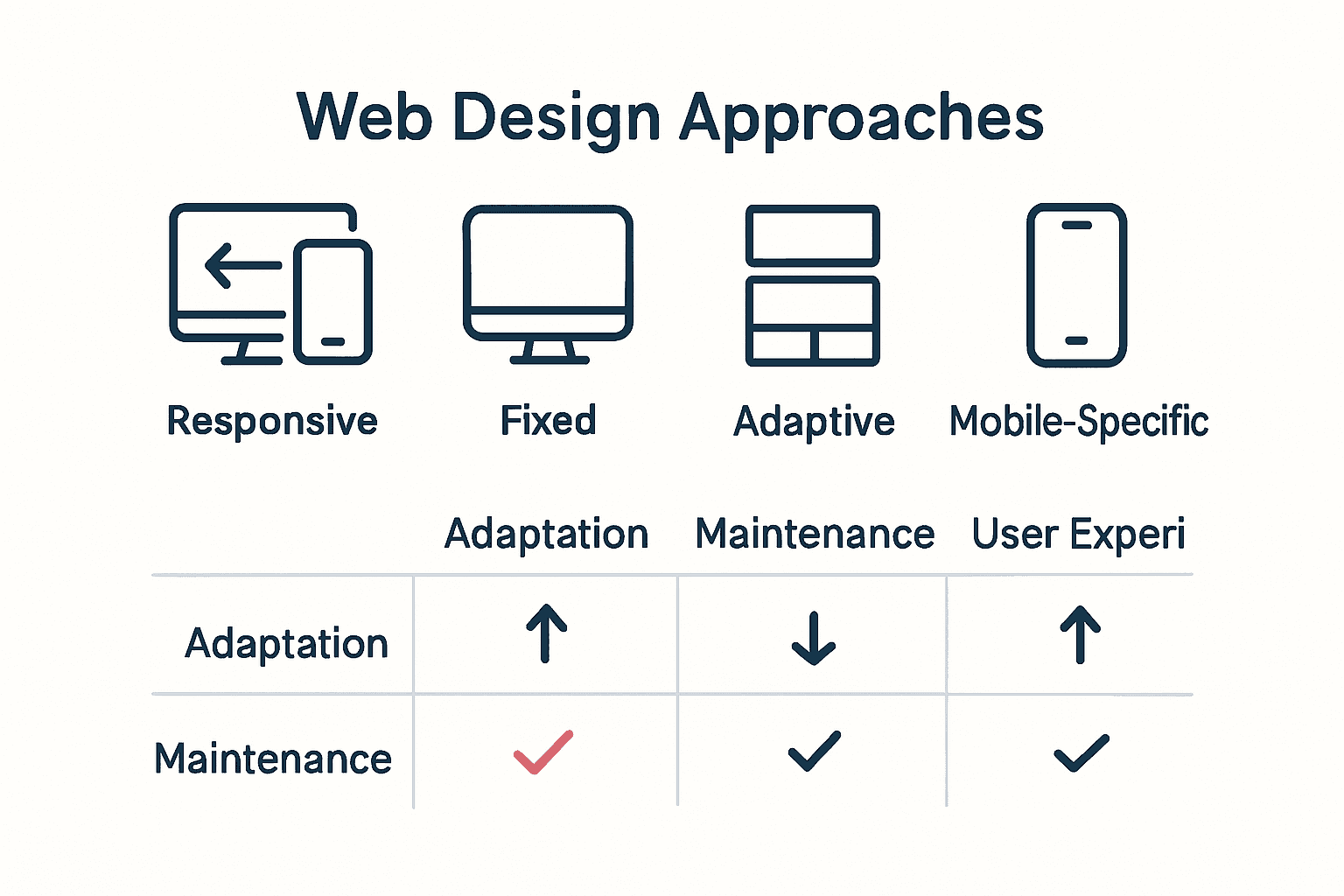
Here’s a comparison of the main web design approaches:
| Approach | Layout Adaptation | Maintenance Effort | User Experience |
|---|---|---|---|
| Responsive Design | Fluid Adapts to any device | Low Single site version | Consistent Seamless across all screens |
| Fixed Layout | Static Unchanged on all devices | Low Simple but inflexible | Poor on mobiles Works on desktops |
| Adaptive Design | Predefined Snap to device categories | Moderate Multiple layouts | Good Specific devices only |
| Mobile-Specific Sites | Separate Unique mobile version | High Multiple codebases | Good on intended device Poor on others |
“Responsive design isn’t just a technique—it’s a philosophy of digital adaptability.”
Customer Review:
“Our website now looks perfect on every device. Responsive design changed everything!” – Sarah Thompson, Digital Marketing Manager
Ready for a Website That Truly Adapts to Your Business?
If you are tired of seeing your website fall short on mobile devices or notice customers leaving because your site is hard to navigate, you are not alone. Many New Zealand businesses struggle with outdated layouts, fixed-width designs, or clunky mobile experiences. The article on responsive design highlighted the frustration and lost opportunities that come when your site cannot keep up with every new device. But your business should not get left behind as technology shifts and user habits change. Discover real solutions in our Website Archives to see how other local brands have overcome these exact challenges.
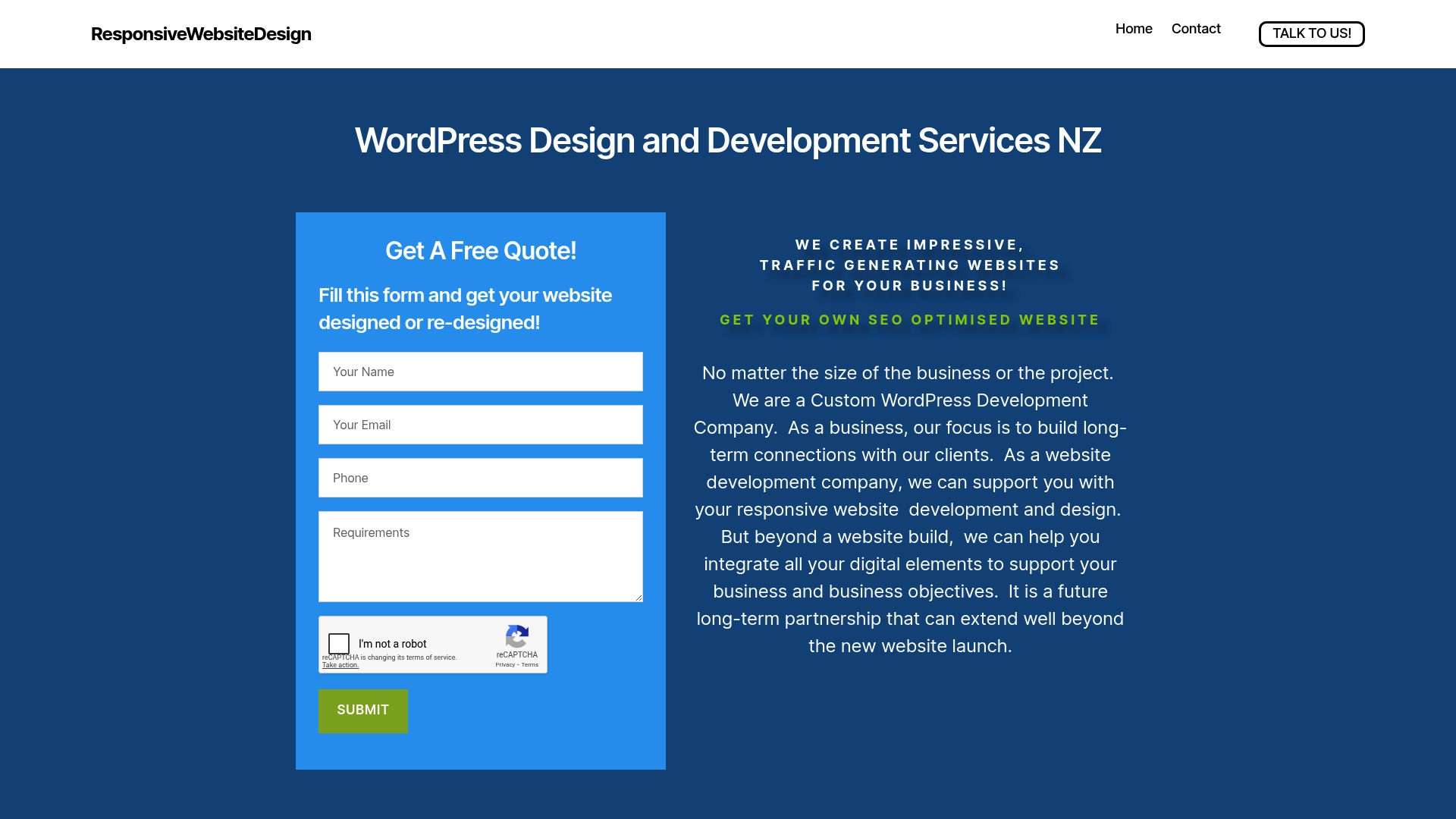
Imagine your brand with a website that looks stunning on every screen, loads fast, and makes navigation effortless for all customers. Our team at ResponsiveWebsiteDesign.co.nz specialises in building smart, responsive WordPress sites that deliver the seamless user experience your customers demand. If you want a digital presence that performs and drives results, explore our tailored approach and let us turn your website into a true business asset. Visit ResponsiveWebsiteDesign.co.nz now to get started on the upgrade your brand deserves.
Frequently Asked Questions
What is responsive design?
Responsive design is an approach to web development that ensures websites automatically adjust their layout, images, and functionality to provide an optimal viewing experience across a variety of devices, including smartphones, tablets, and desktop computers.
Why is responsive design important for businesses?
Responsive design is crucial for businesses because it enhances user experience, reduces bounce rates, improves SEO, and can lead to higher conversion rates. It allows a single website to function properly on multiple devices, minimizing maintenance costs and effort.
What are the key principles of responsive design?
The key principles of responsive design include fluid grids, flexible images, and CSS media queries. Fluid grids resize elements proportionally, flexible images adjust to screen sizes, and media queries apply specific styles based on device characteristics.
How can I test if my website is responsive?
You can test if your website is responsive by resizing your browser window to see if it adapts smoothly to different widths. Alternatively, use online tools or browser developer modes to simulate various device screens and assess how well the site responds to different sizes.
Recommended
- Responsive Web Design Principles and Benefits – ResponsiveWebsiteDesign
- Netbrand, Author at ResponsiveWebsiteDesign
- Why Invest in Web Design: Complete Guide for Business – ResponsiveWebsiteDesign
- Role of Web Development in Business: Complete Guide – ResponsiveWebsiteDesign
- Responsive Web Design in 2025: A Complete Guide for Businesses
- 7 Types of Web Design You Need to Know – Marzipan



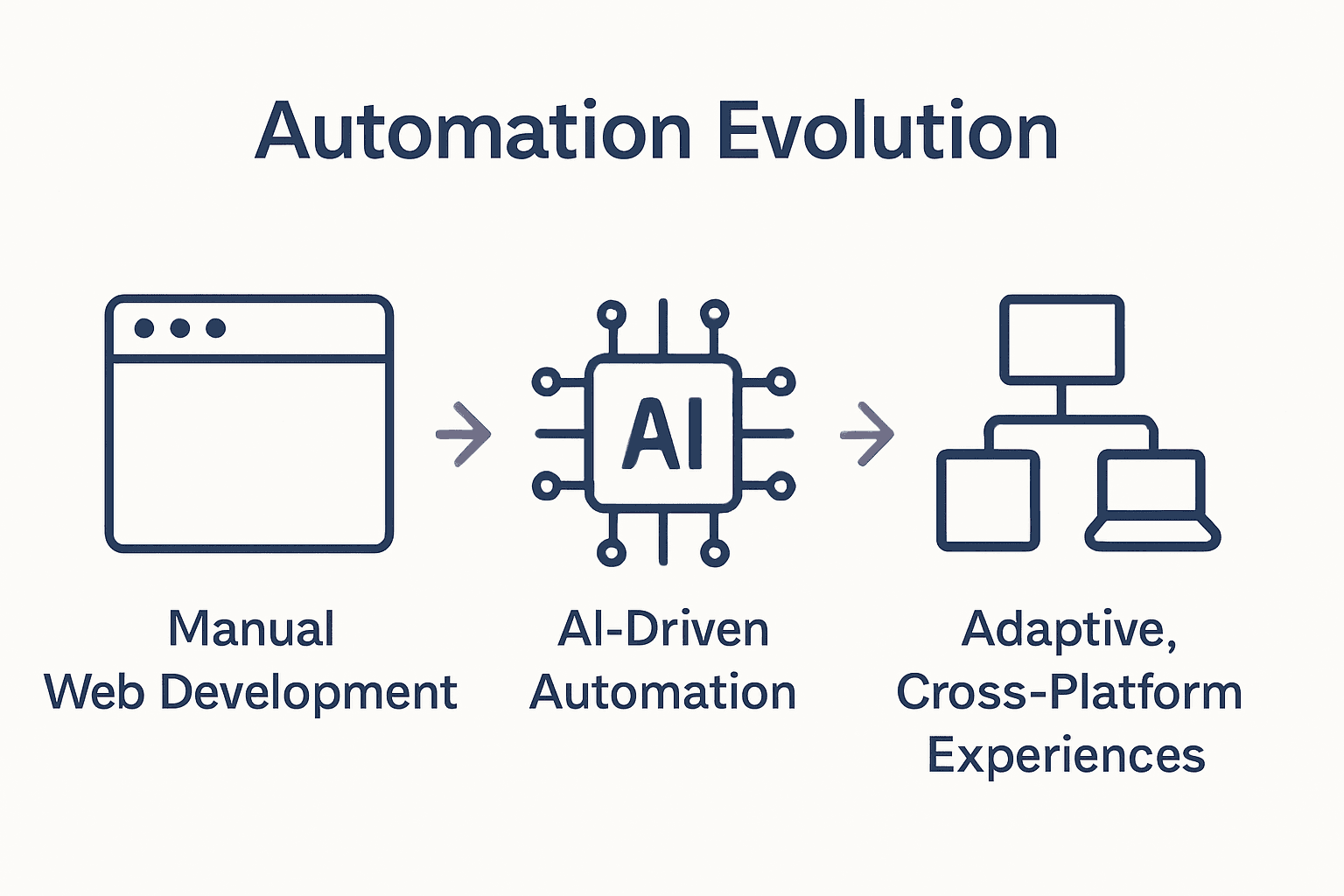 Developers and designers must focus on:
Developers and designers must focus on:

